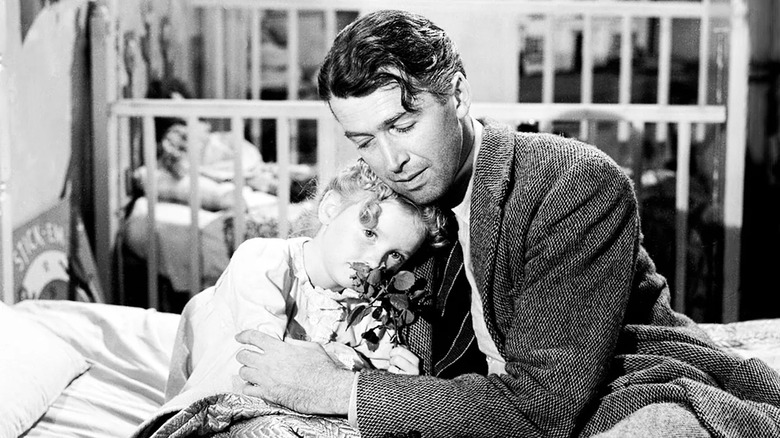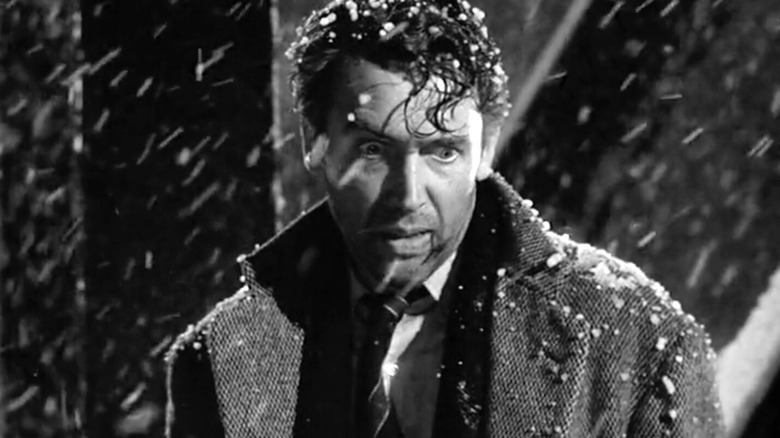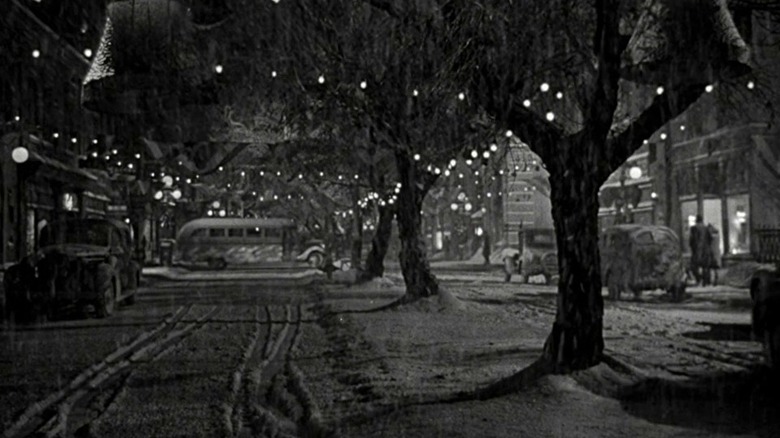It's A Wonderful Life's Massive Set Was Far From A Winter Wonderland
If a character in a film or TV show is watching a Christmas movie, chances are it is Frank Capra's "It's A Wonderful Life." It crops up all over the place, which begs the question: Why not "Miracle on 34th Street" or "Home Alone," or any one of a dozen other festive classics? It's probably down to the instant-recognition factor. A fortunate lapse of copyright meant that TV networks could show it for free, helping it attain a level of ubiquity that other Christmas movies can only dream of. Notably, when clips of the film appear in other media, it is often kind of just "on" rather than something the characters are devoting their full attention to, part of the general fabric of the holiday season.
One of the most commonly used scenes, appearing in everything from "Gremlins" to "The Sopranos," comes from the very end of the movie. If by some miracle you don't know what happens in "It's A Wonderful Life," the protagonist George Bailey (James Stewart) hits rock bottom and considers suicide before an angel shows him what life in his hometown of Bedford Falls would look like without him. It's a nightmarish vision that helps George realize he has a truly wonderful life. Heading back to town, he finds the sleepy burg just as he left it, rather than the sleazy boomtown in the parallel universe he has just witnessed. "Yay!" he cries with happiness and relief before running along the snowy main street, yelling "Merry Christmas!" to passersby and the old familiar landmarks.
After an hour or so of watching George getting his spirit crushed, this is the moment when "It's A Wonderful Life" turns into the most joyous and uplifting thing you've ever seen. This most Christmassy of scenes was far less jolly for the cast and crew, however.
Why is It's A Wonderful Life so enduringly popular?
The strength of "It's A Wonderful Life" is that Frank Capra isn't afraid to take us to some dark places before delivering that cathartic pay-off. Indeed, the conclusion is so joyous that it's easy to forget how grueling the previous hour of the film really is, watching a good man thwarted at every turn until he is driven to despair. It's pretty stark stuff for a film with such a cozy reputation, also tapping into the oft-quoted myth that suicide rates are higher at Christmas time.
What really sells it is James Stewart's magnificent performance. He adds so many extra shades to his well-established nice guy persona, revealing Bailey's inner frustrations with just a twitch of the eyes or allowing his face to cloud over with disappointment or disillusionment, well before he starts berating his kids or contemplating ending it all. It's a performance that earned Stewart an Oscar nomination and hinted at the darker material he would gravitate toward later in his career, particularly his work with Alfred Hitchcock.
Perhaps the reason "It's A Wonderful Life" remains so popular is because, although it ends on a note of ultimate good cheer, it acknowledges that Christmas can be a really rough time for people, too. Bailey pulls back from the brink with a change of heart worthy of Charles Dickens, and the film bridges a gap between the author's "A Christmas Carol" and modern festive classics like "Die Hard," "Bad Santa," and "Elf," all of which contain similar themes. The change of heart message feels especially potent over the holiday season; if you're going to alter your perspective on life, Christmas still feels like the time to do it.
Frank Capra built Bedford Falls from scratch
Just as the famous title dance sequence in "Singin' in the Rain" was shot in a blacked-out studio in the heat of July rather than a real spring downpour, Frank Capra's actors wrapped up for a snowy day under similar conditions for "It's A Wonderful Life."
To create the perfect small American town, the director oversaw the construction of one of the longest sets ever made for a Hollywood movie. Located at the RKO ranch in Encino, California, the newly built Bedford Falls sprawled over four acres, including 75 different buildings and the centerpiece, the main street with its central parkway lined with real oak trees. To add further realism, cats, dogs, and pigeons were allowed to roam around to make the town look more lived-in.
Then came the snow. Capra wasn't content to use the old-school fake stuff that previous movies made to with, so he teamed up with RKO's special effects man Russell Sherman to invent a new kind. They mixed the foam from modern fire extinguishers with sugar, water, and possibly soap flakes to create snow that convincingly flurried, drifted, and clung to the actors' costumes (via Life).
The fantastic set and Capra's new fake snow combined to create the illusion of a picture-perfect white Christmas, but the summer temperatures made things far less frosty for everyone involved. Capra had to give everyone a day off during the shoot to recover from heat exhaustion and Stewart is visibly perspiring in some scenes, most notably the bridge scene when Bailey is contemplating whether or not to jump. I've probably seen the movie 20 times and I guess I always noticed that, but I always took it as a sign of his drunken turmoil in that critical moment. Movie magic can certainly be a sweaty business.


